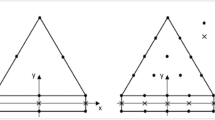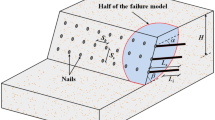Abstract
Soil nailing is commonly used to stabilize cut slopes and earth retaining structures, embankments and sometimes to reduce the lateral earth pressure on retaining wall. This is an in-situ reinforcement technique that uses passive rigid bars usually made up of steel that can withstand tensile forces, shearing forces, and bending moments. In the present study, an attempt has been made to analyze the behavior of soil slope reinforced with soil nails by numerical simulation under seismic loading using a finite element numerical modeling tool, OptumG2. Two-dimensional models of the slope are considered (with and without nails) and subjected to static and dynamic loading to investigate the possible modes of failure (base failure, slope failure, and toe failure). The corresponding factor of safety values for unreinforced soil slope is calculated using the strength reduction method (SRM) at different slope angles (\(\beta )\) at 30°, 40°, 50°. Based upon the obtained critical slope surface in the case of the unreinforced slope, soil nails are provisioned in the slope and the same is analyzed under gravity and seismic loading. A detailed investigation of reinforced soil slope has been conducted considering the key factors governing the factor of safety of reinforced slope namely length of the soil nails, the number of soil nails, spacing of soil nails (s), the inclination of soil nails (\(\theta\)) in different slope angles (\(\beta )\) under seismic loading with a peak horizontal ground acceleration = 0.12 g. The present study also investigates the possible failure patterns under static and seismic conditions, along with the analysis of the development of internal reactions in soil nails such as bending moment and shear force.
Access this chapter
Tax calculation will be finalised at checkout
Purchases are for personal use only
Similar content being viewed by others
References
Alsubal S, Indra SH, Babanigida NM (2017) A typical design of soil nailing system for stabilizing a soil slope: case study. Indian J Sci Technol 10(4). https://doi.org/10.17485/ijst/2017/v10i4/110891
Azzam W. Sobhey MA (2019) Utilization of soil nailing technique to improve sand slopes under seismic loading. In: International conference on advances in structural and geotechnical engineering. Hurghada, Egypt, pp 0–10
Babu GLS, Singh VP (2008) Numerical analysis of performance of soil nail walls in seismic conditions. ISET J Earthquake Technol 31–40
Budania R, Arora RP (2016) Soil nailing for slope stabilization : an overview. Int J Eng Sci Comput 6(12):3877–3882
Fawaz A, Farah E, Hagechehade F (2014) Slope stability analysis using numerical modelling. Am J Civil Eng 2(3):60–67. https://doi.org/10.11648/j.ajce.20140203.11
Federal Highway Administration (FHWA) (2003) Soil nail walls, geotechnical engineering circular no. 7, report no. FHWA0-IF-03–017. Federal Highway Administration
Garzón-Roca J, Capa V, Torrijo FJ, Company J (2019) Designing soil-nailed walls using the amherst wall considering problematic issues during execution and service life. Am Soc Civil Eng 19:1–14. https://doi.org/10.1061/(ASCE)GM.1943-5622.0001453
Kannaujiya P, Chauhan VB (2020) Behavior of anchored sheet pile wall. In: Shehata H, Brandl H, Bouassida M, Sorour T (eds) Sustainable thoughts in ground improvement and soil stability, GeoMEast 2019. Springer, Cham, pp 184–195. https://doi.org/10.1007/978-3-030-34184-8_12
Ojha R, Chauhan VB (2020) Performance of geosynthetic reinforced segmental retaining walls. In: Shehata H, Brandl H, Bouassida M, Sorour T (eds) Sustainable thoughts in ground improvement and soil stability, GeoMEast 2019. Springer, Cham, pp 196–206. https://doi.org/10.1007/978-3-030-34184-8_13
Optum G2 (2017) Optum computational engineering. Copenhagen NV, Denmark
Pandey A, Chauhan VB (2020) Evaluation of pull-out capacity of helical anchors in clay using finite element analysis. Geotechnical Special Publication 2020. GSP 317, pp 60–68. https://doi.org/10.1061/9780784482803.007
Pandey A, Chauhan VB (2020) Numerical analysis for the evaluation of pull-out capacity of helical anchors in sand. In: Shehata H, Brandl H, Bouassida M, Sorour T (eds) Sustainable thoughts in ground improvement and soil stability, GeoMEast 2019. Springer, Cham, pp 207–218. https://doi.org/10.1007/978-3-030-34184-8_14
Rawat P, Chatterjee K (2018) Seismic stability analysis of soil slopes using soil nails. Geotechnical Special Publication, pp 79–87. https://doi.org/10.1061/9780784481486.009
Rawat S, Gupta AK (2016) Analysis of a nailed soil slope using limit equilibrium and finite element methods. Int J Geosynth Ground Eng. https://doi.org/10.1007/s40891-016-0076-0
Seyed-Kolbadi SM, Sadoghi-Yazdi J, Hariri-Ardebili MA (2019) An improved strength reduction-based slope stability analysis. Geosciences 1–11. https://doi.org/10.3390/geosciences9010055
Sengupta A, Giri D (2011) Dynamic analysis of soil-nailed slope. Ground Improve 164:225–234. https://doi.org/10.1680/grim.8.00023
Author information
Authors and Affiliations
Corresponding author
Editor information
Editors and Affiliations
Rights and permissions
Copyright information
© 2021 The Author(s), under exclusive license to Springer Nature Singapore Pte Ltd.
About this paper
Cite this paper
Pandey, A., Jaiswal, S., Chauhan, V.B. (2021). Numerical Studies on the Behavior of Slope Reinforced with Soil Nails. In: Sitharam, T.G., Jakka, R., Govindaraju, L. (eds) Local Site Effects and Ground Failures. Lecture Notes in Civil Engineering, vol 117. Springer, Singapore. https://doi.org/10.1007/978-981-15-9984-2_19
Download citation
DOI: https://doi.org/10.1007/978-981-15-9984-2_19
Published:
Publisher Name: Springer, Singapore
Print ISBN: 978-981-15-9983-5
Online ISBN: 978-981-15-9984-2
eBook Packages: EngineeringEngineering (R0)




